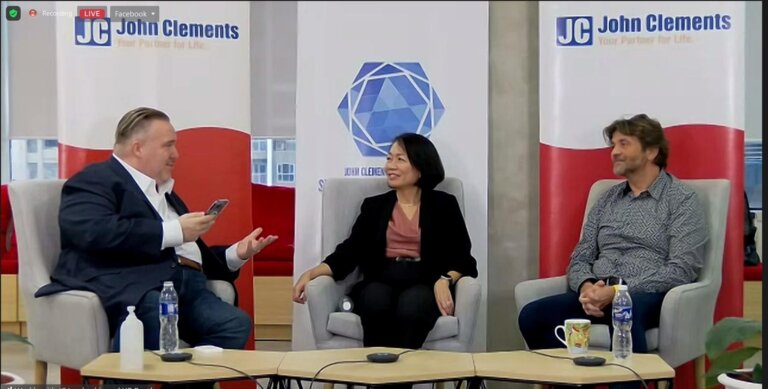“We have stories every day of who we are and what we do, to drive a message, a strategy, and develop stories that give us lessons and goals. Great Leaders are also great storytellers—the great storyteller has the power to convince listeners to support and establish connections with the audience.”
This was part of the inspiring opening message of Grace Sorongon, Senior Vice President and Managing Director of John Clements Consultants’ Professional Staffers Division, on a very interesting topic—“Crafting Compelling Tales: Using Stories to Drive Business Outcomes”—at the 2nd Weekly with JC Leadership and HR Series Fireside Chat last May 4, 2023. This session featured Sam White, HR Director of Ingram Micro; Horia Adrian, CEO of Holcim Philippines Inc.; and Riza Mantaring, former CEO and Country Head of Sun Life Financial Philippines.
Grace Sorongon opened the fireside chat by asking the panelists about their respective experiences in storytelling and how these made an impact on their organizations. Sam White answered by sharing an experience from 16 years ago as the Senior Vice President of a bank in the U.S., which they were about to set up in the Philippines. He had initially planned to employ and train someone who was qualified for the position, but he was offered the position instead. He shared that he had thought about what could prevent him from experiencing another country’s culture and debated whether he should be accepting the role. He finally gave it a shot for 18 months, before gladly staying for the next 15 years. His narrative demonstrated risk-taking, innovation, and courage.
Riza Mantaring talked about her journey as Sun Life Financial’s CEO. She shared that she took over this position in a time when the sector had been in a dismal state for ten years. One day when she was planning to launch campaigns using the classroom PowerPoint presentation, her superior suggested that they, instead, do a role play wherein the leaders will act as the campaigns’ actors. They performed these plays in every branch across the nation, highlighting the value of their service and financial literacy. Because the process was so enjoyable, they have developed different themes for each quarter throughout the years. They increased at a trigger rate of 42% each year for the next five years. Her story has an organizational impact because it helped their team remember what their leaders expected of them.
Horia Adrian narrated how he began as a mechanical engineer working in a shipyard, and how he ultimately left his post to pursue other opportunities. He applied for a project manager position, traveled to the Romanian capital at that time, and went to a recruiting firm. He was then given the opportunity to join Holcim, a company that dealt with concrete, despite having little prior experience in the field. He gave it a chance and approached difficulties with a positive attitude. His story showed that it’s important to embrace new opportunities because life is a learning journey–don’t be afraid to go out of the box.

During the active exchange of stories and ideas on creating compelling stories that can build connections within the organization, I learned some important tips on developing stories that can have a cultural impact on the organization. These are:
1. Make it simple and understandable—create a story that can target three to five key messages; anything more than that isn’t a strong story, so make it clear and simple to grasp. Always strive to express this with authenticity. Talk about its impact and make it specific and accessible.
2. Make it relatable—consider your audience and how you can relate to them. Plan your speech, consider your message, and observe their facial responses. Try to communicate in a way that can make your audience understand and grasp the message.
3. Be authentic—be honest about your story; because if you get caught, it will take away the impact, along with your credibility.
4. Use artistic management—always integrate a creative and fun play on your workplace culture.
5. Adjust your style to include all your audience’s style—avoid telling inappropriate and not-in-a-particular-moment stories, as well as to the wrong audience. Instead of telling them what you want to say, concentrate on what they can understand. When communicating, you should use a solid balance of formal and casual communication to engage with your audience.
6. Make it vivid—so your audience can remember your stories. When crafting your story, decide who the protagonist and antagonist are.
7. Be vulnerable and open—we are all fallible human beings; it is inevitable that we will make errors. Be upfront and vulnerable. Show what went wrong and the lesson you learned. Don’t hesitate to talk about your weaknesses because doing so will help you gain your audience’s trust.
8. Importance of two-way communication—listen attentively, speak clearly, and consider how you would like to be addressed when conversing with someone. Include the audience in the discourse.
Lastly, on a question of how to relay the message of a compelling story to a younger generation, Riza answered that as business leaders, we have to accept that this is not our strength. We need to get younger people to perform in their manner of choosing, in order to connect with a younger audience. Riza then gave three crucial lessons about the younger generation:
1. Purpose—they must have a reason for what they are doing; thus, we must establish a company’s purpose they can relate to.
2. Passion—you need to genuinely engage people and awaken their enthusiasm for things that are significant to them.
3. Play—create an enjoyable environment.

Please visit our events page to learn more about our upcoming events.




